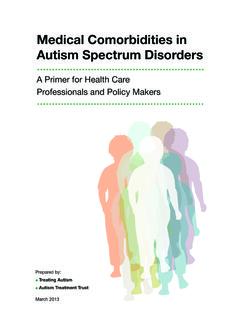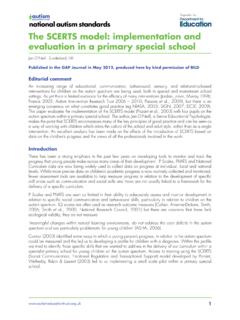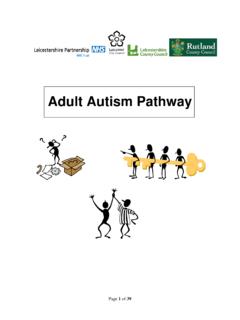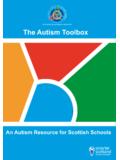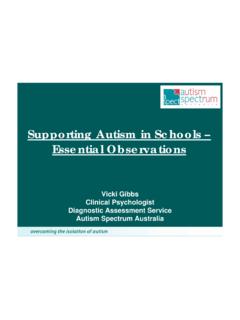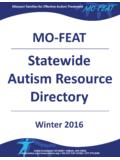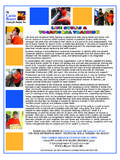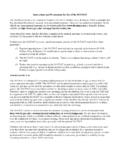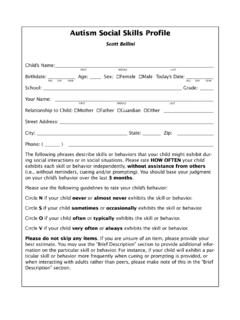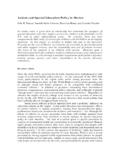Transcription of Behind Closed Doors: What’s Happening to ... - …
1 Behind Closed doors : what 's Happening to students with autism in America's Public Schools? The case for cameras in self-contained classrooms Leslie Phillips - National autism Association, January 25, 2012. Contact: Executive Summary The Centers for Disease Control and Prevention (CDC) estimates one in 88. children born in 2000 are diagnosed with an autism spectrum disorder. This represents a more than 68 percent increase in autism rates in only eight years. The dramatic impact of this epidemic has been keenly felt by school districts nationwide struggling to cope with students who often have a high level of need for supports and services to be provided a Free and Appropriate Public Education (FAPE) as guaranteed under the Individuals with Disabilities Education Act, part B for students identified with autism .
2 Often, the most profoundly affected children are relegated to segregated environments in what are referred to as self-contained classrooms. They spend their entire school days Behind Closed doors with teachers and aides who often have little training in autism , and with no surveillance and little oversight to ensure consistent educational and safety standards. Many of these students are unable to communicate with trusted adults about what is Happening at school. Tragically, this recipe of inadequate screening of prospective teachers and aides, poor training, students who sometimes have very challenging behaviors, and lack of oversight has resulted in an alarming increase in reported incidents of student abuse.
3 Certainly, lack of education funding has greatly exacerbated issues of staffing and training, and with expected cutbacks, the situation will further deteriorate. Data regarding Texas' public schools shows a student with autism is 25 times more likely to be restrained in a self-contained classroom than in general education environments, an indication that difficult situations are much more common in these classrooms. The installation of surveillance cameras in self-contained classrooms would provide students a critical safeguard to maintain personal safety, assure teachers protection from false allegations, and likely save taxpayer money by avoiding 2. expensive and protracted investigations into allegations of abuse by providing solid documentary evidence.
4 Introduction A dramatic increase in the number of students receiving special education services under the eligibility label of autism has caused tremendous strain in public schools struggling to serve a population with a high level of need. According to the Texas Education Agency, the number of students receiving special education services with the eligibility label of AU (for students with autism spectrum disorders) increased from 26,603 in the 2008-2009 school year to 37,361 in 2011-2012, an increase of greater than 40 percent in only three years. Parents report meetings to negotiate for services to assure a FAPE in the Least Restrictive Environment (LRE), as promised under the Individuals with Disabilities Education Act (IDEA) have become battlegrounds.
5 While education in inclusive environments is often the goal, sometimes the intensity of support required for a student results in placement apart from general education settings in self-contained classrooms. This paper addresses concerns related to abuse that occurs in these segregated settings. what is unique to autism that puts our kids at risk? Chief among the difficulties of educating students with autism is challenging behavior. Whatever the cognitive ability of a student with autism , problems with social skills, self-regulation and self-awareness can become barriers to participation in general education environments, especially if behaviors are not appropriately addressed early on.
6 While a large body of scientific research points to the efficacy of Applied Behavior Analysis (ABA) to develop functional behavioral analysis (FBA) resulting in a Behavior Intervention Plan (BIP). individualized to the student, the promise of inclusion all too often is not realized. 3. It is often behavioral challenges that lead to educational placement in self- contained classrooms as a student's primary instructional setting. The self- contained classroom, as the name implies, limits access to the school community, often resulting in sequestration of students , teachers and other personnel Behind Closed doors for most of the school day. The restricted setting per se is not the problem.
7 Some students may make better progress in settings that minimize distractions and provide intensity of instruction they need in order to learn. The problem lies in the fact that many children with autism who have been determined to need this placement are non-verbal, limited, or unreliable communicators who cannot tell trusted adults when things go wrong at school. Classmates, likewise, are often unable to report abuse. As media reports have unfortunately revealed, collusion between two or more adults to cover up abuse is alarmingly common. with the explosion of students with autism has come a corresponding increase in students in these placements. The National autism Association monitors media reports of cases of student abuse and has observed what appears to be a steady increase in instances of abuse perpetrated by trusted adults including teachers, therapists and paraprofessionals.
8 All too often, the abuse goes undetected (because of the students ' communication challenges) until obvious signs or symptoms arise. Undoubtedly, there are some cases of abuse that are never detected. what should be Happening ? The Office of Special Education Programs (OSEP) of the US Department of Education endorses Positive Behavioral Interventions and Supports (PBIS) as an effective, evidence-based disciplinary practice using a three-tiered approach from broader school-wide efforts to specific strategies for students with significant behavior challenges. 4. The primary tier of PBIS involves core elements including having clear behavior expectations defined and taught, reward systems for appropriate behavior, and consequences for problem behavior.
9 It also includes the use of data to drive decision-making. The secondary tier involves universal screening, efforts to improve school-home communication, increasing structure, and other tenets. The third, most intensive tier, called the tertiary tier, involves the use of Functional Behavioral Assessments (FBA). Ideally, an intensive team-based approach should be used to perform needed evaluations resulting in the development of an individualized Behavior Intervention Plan (BIP) for students whose behavior challenges have not responded to tier one and two approaches. In a March 2009 paper, OSEP cites 19 studies showing support for use of the organizational systems and strategies defined in the tertiary PBIS intervention tier.
10 Simply put, if an FBA is properly done -- and the BIP is properly developed and implemented -- PBIS works. Unfortunately, students with autism (and other students with challenging behaviors) are often denied this support because the process by definition is rigorous, and can be costly on the front end. Failures include not performing FBAs at all, or using short cuts which result in bad BIPs that don't help -- and sometimes exacerbate -- behavior problems. A student who languishes with a poor FBA and BIP can struggle for years, be denied education in the Least Restrictive Environment (LRE) and, in some difficult cases, be subject to abusive practices, either under the guise of aversives (negative and sometimes abusive practices such as spraying lemon water to the eyes) or outright abuse by teachers and aides who may have neither the right training, nor the right tools to implement a good behavior plan.
